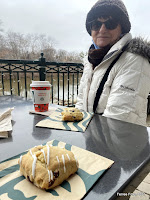Originally
published in Canton Daily Ledger Column on 12-4-04
Last weekend my husband Mark hung a new birdfeeder in the
ash tree behind our house. I’m looking forward to the birds finding it. I have
a great view of it from my kitchen window. We have another feeder at the front
of the house that typically attracts many birds.
If you want to begin feeding birds, now is the best time to
start your bird-feeding program according to Bob Frazee, University of Illinois
Natural Resources Educator. Birds, small mammals, and other wildlife are
actively seeking food sources to fatten up for migration or for winter temperatures
if they are year-round residents. By having your feeders up early, there is a
better opportunity for birds to find the feeder and become accustomed to using
it before winter arrives in earnest.
Since enjoying birds is a major objective, you will want to
locate the feeder where it can be conveniently viewed – and used. Due to
differences in body size, feet and bills, birds not only prefer different
seeds, but also different foraging areas. This does not mean that birds will
never feed in a different area, but you will increase your chances by catering
to their feeding preferences.
Birds such as juncos, sparrows, cardinals, blue jays, and
mourning doves prefer to forage on the ground for seeds. Frazee notes that you
will often observe these birds hopping around the lower branches of shrubs and
rustling through leaf litter in search of seeds and berries. A small brush
pile, open lean-to or grassy patch provides cover for ground-feeding birds
while they eat.
A covered tray feeder raised off the ground on a fence or
pole is the most common feeder you see in people’s yards. Tray feeders will
accommodate most of the ground feeders plus chickadees, nuthatches, and finches.
While this type of feeder will attract the widest variety of birds, the seeds
are not protected from the weather and can get wet and/or moldy. Frazee
cautions that squirrels and large birds, such as grackles and blue jays may
also invade a tray feeder.
 |
| Finches eating niger seed |
Hanging feeders may include hopper, silo and tube feeders
with perches. Hung from a branch, eaves, or a clothesline, these feeders sway
freely in the wind, which doesn’t bother birds such as finches, chickadees,
woodpeckers, and nuthatches. However, some birds, such as sparrows, get a
little “sea-sick” and prefer more stability. Frazee encourages filling large
hanging feeders with sunflower seeds to attract cardinals and blue jays. Small
feeders should be geared more toward finches, chickadees, nuthatches and tufted
titmice. Niger seed is very attractive to goldfinches and works well in
small-hole tube feeders, which avoid waste.
Woodpeckers and nuthatches are primarily insect eaters. They
prefer foods high in protein and fat such as suet and peanut butter that can be
dispersed in clinging feeders. Made of hardware cloth, mesh bags, pinecones,
coconuts or other “structures” lacking perches, clinging feeders are excellent
for dispensing peanuts to smaller birds or suet to insect-eaters.
Lastly, just like persnickety kids, birds have different
food preferences. Hands down, black-oil sunflower seeds are the most popular
food among a large variety of birds. Juncos and sparrows go wild for white
proso millet, goldfinches can’t resist niger seed, and chickadees and titmice
will delightfully indulge themselves with peanuts. In a nutshell, Frazee
concludes that the key to successfully attracting wildlife to your backyard is
to add variety.
Original Source: Bob
Frazee, Retired University of Illinois Extension Natural Resources Management
Educator






































